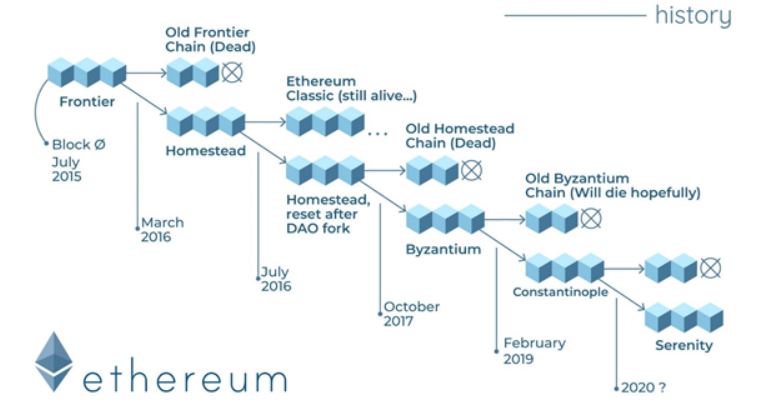One of the most highly anticipated events in the cryptocurrency world is Ethereum’s transition into a Proof-of-Stake (PoS) consensus mechanism, dubbed Ethereum 2.0. Among other features, Ethereum 2.0 offers staking ETH, making it possible for the first time to provide current holders of ETH with positive returns (similar to interest). eToro plans to be among the first to offer this possibility to our customers and are currently following all the required developments as well as the security implications for our clients.
The new and improved Ethereum blockchain will seek to enhance speed and scalability, while maintaining the core principle of decentralisation, a trade-off which has often been a huge implementation challenge in the cryptocurrency space. While the official date for the launch of Ethereum 2.0 is still unknown, Ethereum’s co-founder, Vitalik Buterin, recently discussed the detailed roadmap for the highly anticipated Ethereum 2.0 protocol.
Initial Ethereum Roadmap
Ethereum is divided into four key stages of development to facilitate a smoother and more efficient development process.

Source: Ethereum Roadmap
Phase 1: Frontier
Frontier was the original release of the Ethereum network, which went live in July 2015. It was a bare bones version designed for developers to experiment with and build early forms of dApps.
Phase 2: Homestead
Homestead is the first production release of Ethereum that integrated protocol and networking changes to facilitate future network upgrades. This rollout entailed three major improvements including the removal of the network’s centralisation feature, enabling users to transact with Ethereum’s native coin (ETH) and facilitating the writing and deployment of smart contracts.
Phase 3: Metropolis
Metropolis represents the third stage of the Ethereum roadmap and is broken down into two stages: Byzantium and Constantinople. Byzantium is a backward compatible upgrade that entails the integration of a privacy mechanism called zero-knowledge protocol (zkSNARKs) as well as the delay of the network’s “difficulty bomb.” Constantinople represents a hard fork (non-backward compatible) that was deployed to close a major security weakness which allowed hackers to access user funds. A prominent improvement of Constantinople was the integration of the smart contract functionality that enhanced the verification process as well as the reduction of gas fees.
Phase 4: Serenity
Serenity is the final stage of Ethereum’s development which will see it transition from a Proof-of-Work (POW) consensus algorithm to a PoS system. Although highly secure, the PoW system consumes too much electricity and leaves a significant carbon footprint. With the PoS system, the computational and electrical resources needed to secure the Ethereum network will decrease and it also has more scaling potential than PoW.

Ethereum 2.0: A New & Updated Roadmap
Initially, Byzantium and Constantinople (under the Metropolis stage) were supposed to lay the foundations for the eventual transition to the proposed PoS system. Specifically, Constantinople was originally supposed to include a hybrid PoW and PoS system to facilitate a smooth transition. However, developers in the Ethereum community decided that it was best to ditch this idea. This led to a delay in the implementation of certain upgrades, manifested in the latest roadmap, called Ethereum 2.0.
Ethereum 2.0 is essentially the Serenity phase of the previous roadmap, with greater clarity of the progressive updates. The proposed Ethereum 2.0 roadmap is broken down into three major phases, with each stage being introduced into the protocol in a safe environment without compromising the security and functioning of the blockchain.
Beacon Chain
The first phase of Serenity will entail the release of Beacon Chain, marking the execution of the long-awaited transition to the PoS system. Beacon Chain is a PoS chain that will run in parallel to Ethereum’s current PoW chain. This hybrid approach will facilitate the transition phase to ensure the functionality and continuity of the current processes. At the first implementation, Beacon Chain will be a bare bones structure engineered for simplicity and will not support accounts or smart contracts at the outset. Under the PoS system, two-thirds of validators (miners) would need to stake ETH on the next block, thereby making the economic (dis)incentive riskier for malicious actors looking to compromise the security of the network.
Under the PoS system, consensus is achieved through the work of a validator who is required to “stake” a fixed amount of ETH in order to participate in the mining process. The validator’s role is to validate new transactions via a voting process and thereafter propose a block (filled with validated transactions) to the chain. For their work, validators will be rewarded with more ETH, similar to an interest-earning fixed deposit product. In the event that the validator chooses to act maliciously, he will lose all of his staked ETH. The required number of staked ETH for validators’ stands is 32.
Sharding
The second phase of development is focused on significantly enhancing Ethereum’s scalability capabilities. A new technological advancement, called “Sharding” enables much higher transaction processing and output by dividing the data processing responsibility among nodes in the network. Sharding refers to the partitioning of a large database into smaller chunks of “shards” each of which has its own chain of transactions. The division of work into multiple shards would facilitate parallel processing and storing of transactions, allowing the network to validate many transactions concurrently.
Vitalik explains the concept of sharding as follows:
“Imagine that Ethereum has been split into thousands of islands. Each island can do its own thing. Each of the islands has its own unique features and everyone belonging on that island, i.e., the accounts, can interact with each other and they can freely indulge in all its features. If they want to contact other islands, they will have to use some sort of protocol.”
eWASM
The last phase of the roadmap will introduce a more advanced Ethereum Virtual Machine (EVM) that encapsulates both PoS and sharding. The new EVM, called “Ethereum-flavoured Web Assembly” (eWASM), would enhance the functionality of shard chains from basic data markers to fully functioning transactional chains. This would increase Ethereum’s scalability prospects. At this point, accounts, states and smart contracts would be reintroduced.
Conclusion
After years of research and development, Ethereum has finally released the last stage of the Ethereum roadmap. The main reason that many are looking forward to Ethereum’s development is because it could potentially solve the core scaling issue plaguing the blockchain space. If introduced correctly, Ethereum’s solution would be an elegant answer to addressing the scalability issue without compromising the decentralised nature and security aspects of the blockchain. With an ambitious goal in mind, Ethereum is poised to maintain its crown of being the largest smart contract computing platform in the industry.

